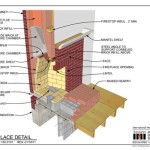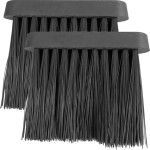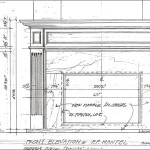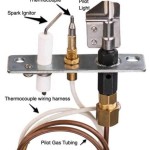Gas Fireplace Facade: Enhancing Aesthetics and Functionality
A gas fireplace facade serves as the visible presentation of a gas fireplace, greatly impacting the overall aesthetic of a room. More than just a decorative element, the facade also plays a functional role, contributing to safety and efficiency. Understanding the components, materials, and design considerations involved in selecting a gas fireplace facade is crucial for homeowners and designers aiming to achieve a specific style and enhance the value of a property.
The term "facade" encompasses the facing or outer appearance of the fireplace, often concealing the internal mechanics and venting system. It is the element most readily perceived and, therefore, a significant factor in dictating the visual appeal. A well-chosen facade can transform a simple fireplace into a stunning focal point, harmonizing with the room's décor or making a deliberate statement.
Gas fireplace facades are available in a wide array of styles, from classic and traditional to contemporary and minimalist. The selection process should consider the existing architectural features of the room, the desired ambiance, and the homeowner's personal preferences. Factors such as color, texture, and material composition all contribute to the overall impression created by the facade.
Material Selection: Balancing Aesthetics and Practicality
The materials used in constructing a gas fireplace facade significantly influence its durability, appearance, and maintenance requirements. Common materials include stone, brick, tile, wood, and metal, each offering unique advantages and disadvantages.
Stone facades, whether natural or manufactured, provide a timeless and elegant look. Natural stone options like granite, marble, and slate offer inherent variations in color and texture, creating a unique and luxurious feel. However, natural stone can be expensive and require specialized installation. Manufactured stone, on the other hand, offers a more cost-effective alternative with consistent color and texture, while still providing a realistic stone appearance.
Brick facades evoke a sense of traditional warmth and character. They are durable, fire-resistant, and relatively low-maintenance. Brick can be painted or stained to achieve different color palettes and aesthetic effects. The texture of brick can also vary, from smooth and uniform to rough and rustic.
Tile facades offer versatility in design, allowing for intricate patterns and color combinations. Ceramic, porcelain, and glass tiles are popular choices, each with varying levels of durability and water resistance. Tile is relatively easy to clean and maintain, making it a practical option for many homeowners.
Wood facades can add a touch of warmth and natural beauty to a room. However, wood requires careful consideration due to its flammability. It's essential to use fire-resistant wood or treat the wood with fire-retardant coatings. Wood facades may also require more maintenance than other materials, such as regular sealing or painting.
Metal facades, often made of steel, copper, or aluminum, offer a sleek and modern aesthetic. Metal is durable, fire-resistant, and easy to clean. It can be finished in various colors and textures, including brushed, polished, or powder-coated. Metal facades are often used in contemporary homes and commercial spaces.
Design Considerations: Harmonizing with the Surrounding Environment
Effective gas fireplace facade design involves careful consideration of the surrounding environment and the overall aesthetic goals. The facade should complement the existing architecture, color scheme, and furniture in the room. It should also be proportional to the size of the fireplace and the room itself.
Scale and proportion are critical design elements. A facade that is too large or too small can disrupt the visual balance of the room. The height and width of the facade should be carefully considered in relation to the dimensions of the fireplace and the surrounding walls. The depth of the facade can also impact the overall appearance, adding dimension and visual interest.
Color choices play a significant role in creating the desired mood and atmosphere. Neutral colors, such as white, gray, and beige, create a sense of calm and sophistication. Bold colors, such as red, blue, and green, can add drama and personality. The color of the facade should complement the existing color palette in the room and create a cohesive design.
Texture adds visual interest and depth to the facade. Rough textures, such as natural stone or brick, create a rustic and inviting feel. Smooth textures, such as polished metal or glass tile, create a modern and sophisticated look. The texture of the facade should be carefully considered in relation to the overall design style.
Lighting can also enhance the appearance of the gas fireplace facade. Strategically placed lighting can highlight the texture and color of the facade, creating a dramatic and inviting focal point. Recessed lighting, spotlights, and sconces can all be used to illuminate the facade and create different lighting effects.
Installation and Safety: Ensuring Proper Functionality
Proper installation is crucial for ensuring the safe and efficient operation of a gas fireplace facade. Incorrect installation can lead to serious safety hazards, such as gas leaks and carbon monoxide poisoning. It is essential to hire a qualified and licensed professional to install the facade.
The installation process typically involves preparing the fireplace opening, installing the venting system, and attaching the facade to the fireplace frame. The installer must ensure that all components are properly aligned and sealed to prevent gas leaks and ensure proper ventilation.
Safety codes and regulations regarding gas fireplace installation vary by location. It is important to check with local authorities to ensure that the installation complies with all applicable codes. This may include obtaining permits and inspections.
Regular maintenance is also essential for ensuring the continued safe and efficient operation of a gas fireplace facade. This includes inspecting the venting system, cleaning the facade, and checking for any signs of damage or wear. A qualified technician should inspect the fireplace annually to ensure that it is operating properly.
Homeowners should also be aware of the symptoms of carbon monoxide poisoning, such as headache, dizziness, and nausea. If these symptoms occur, it is essential to evacuate the premises immediately and call for emergency assistance.

7 Fireplace Surround Ideas That Will Ignite The Room

Types Of Fireplaces And Mantels The Home Depot
Debating A Modern Or Traditional Fireplace Heat Glo

Imperial Keenan Mantels Mi Gas Fireplace Mantel Toronto Best

Marquess Keenan Mantels Mm Gas Fireplace Mantel Toronto Best

Majestic Quartz36ift Quartz 36 Inch Direct Vent Gas Fireplace
Gas Fireplace And Stone Surround The Grate Haus

Buck Stove Model 1127 Corner Mantel Gas Fireplace Fireplaces Usa

Diy Faux Plaster Fireplace Surround Chelsey Freng

Jeff S Stone Veneer Gas Fireplace Surround Genstone








